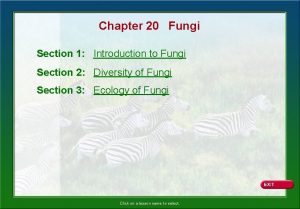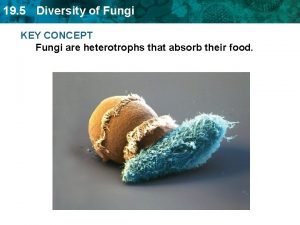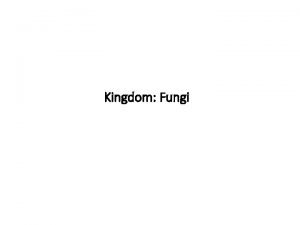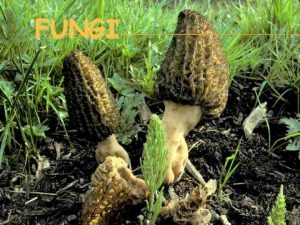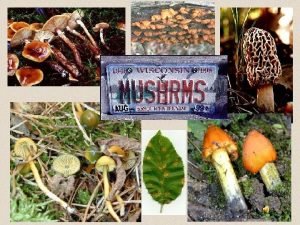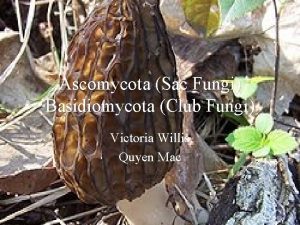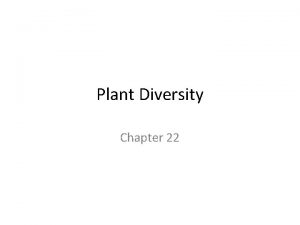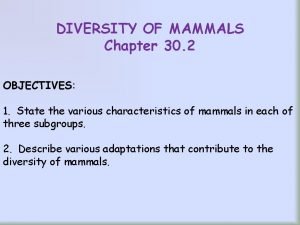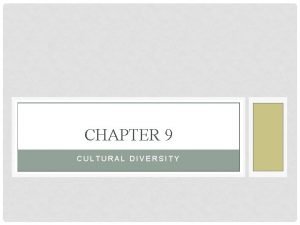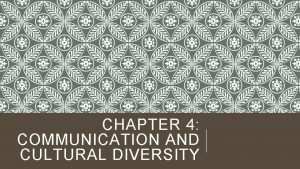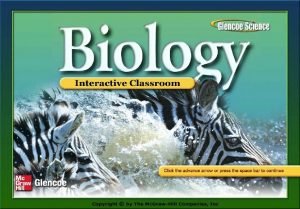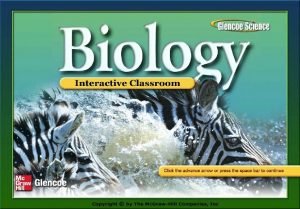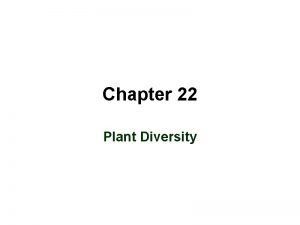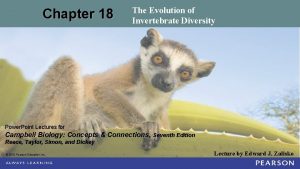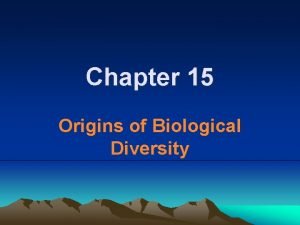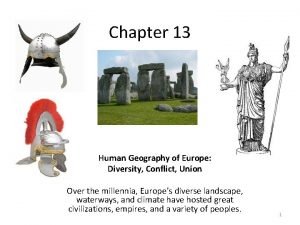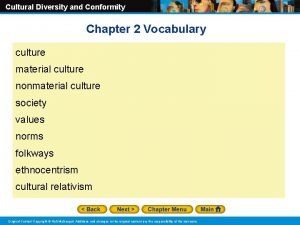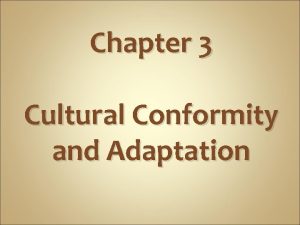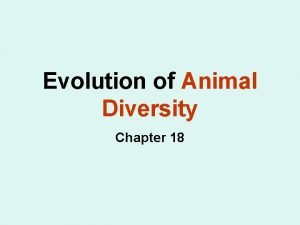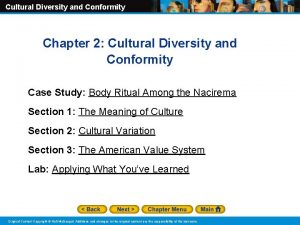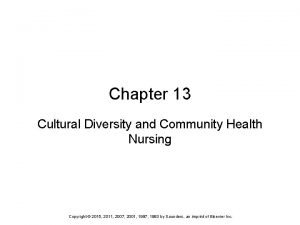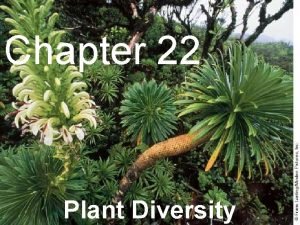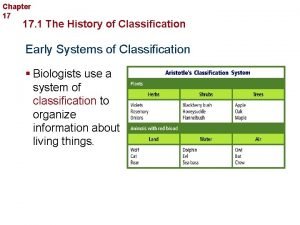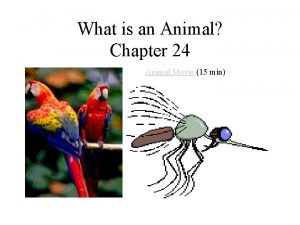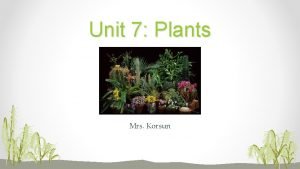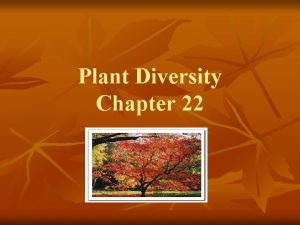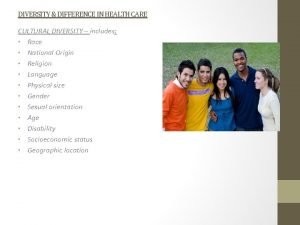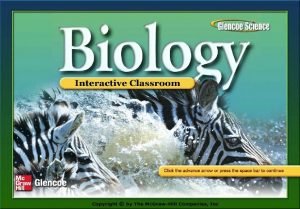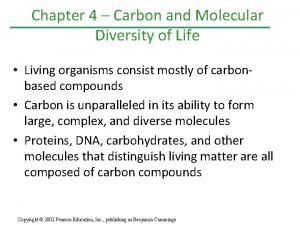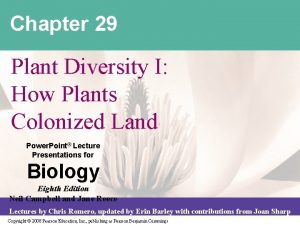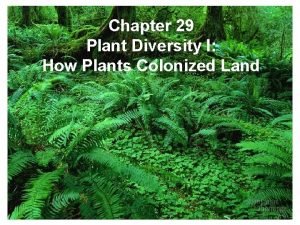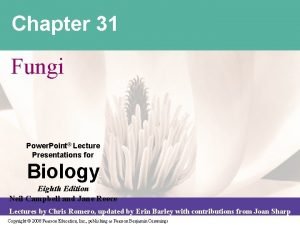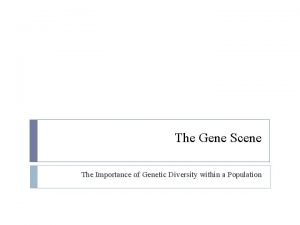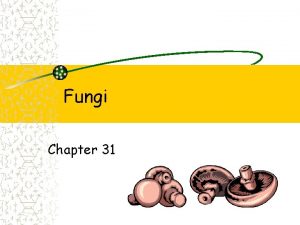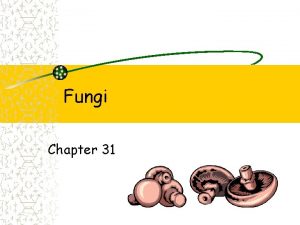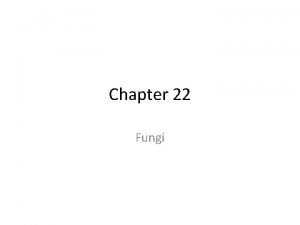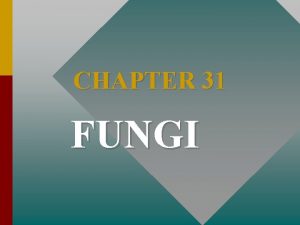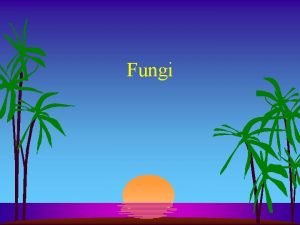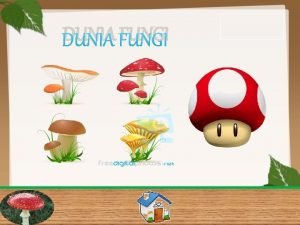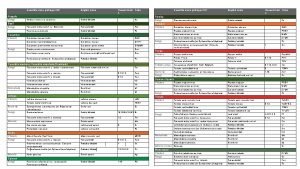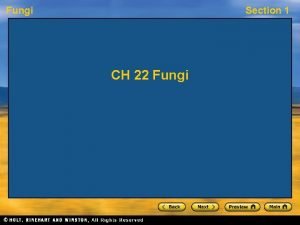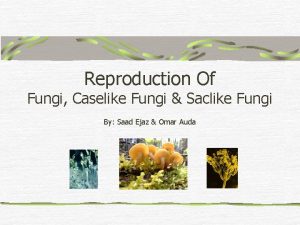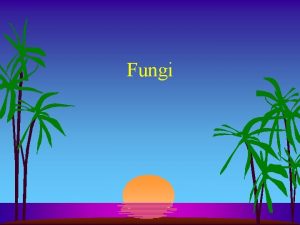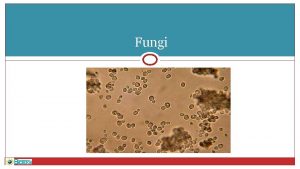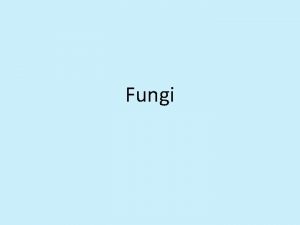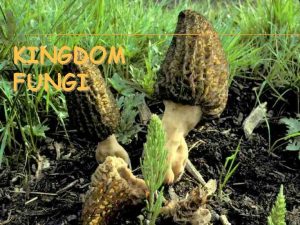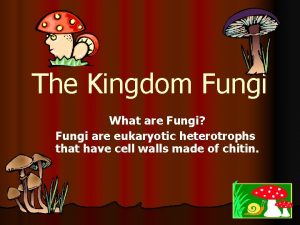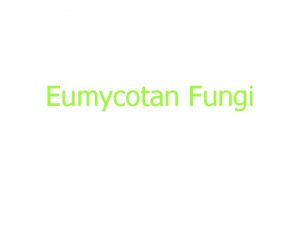Chapter 20 1 Diversity of Fungi FUNGI FUNGI




















































- Slides: 52

Chapter 20. 1 Diversity of Fungi

FUNGI

FUNGI • COMMON FUNGI EXAMPLES: – Mushrooms, yeasts, molds, morels, bracket fungi, puff balls

Key Concepts: • Fungi are heterotrophs • Fungi are the decomposers • Fungi use extracellular digestion – when enzymes are secreted outside of their body to digest food • Most fungi are multicellular • Fungal spores develop from hyphae • Many fungi are symbionts with other organisms

Characteristics of Fungi • Multicellular – Plant looking – Mushrooms, molds • Single cell – Yeasts – Found in soil, on plants, in humans Yeast – Bread, beer, wine – Cause yeast infections in humans

3 Major Features 1. Cell walls – Made of Chitin – The same stuff that makes insects’ exoskeleton.

2. Hyphae • • The basic structure of fungi. Long, thread-like chains of cells. Grow at the tips and branch… Mycelium – mass of hyphae

3. Cross-walls • The wall that divides cells • “septum”

FUNGI • FRUITING BODY – Visible part – Contains spore producing structures – Like a mushroom cap Button

Fungi Nutrition • 3 ways fungi absorb nutrition: – Saprophytic – feed on dead matter • Example – bracket fungi – Parasitic - feed on living organisms and only the parasite benefits from the relationship • Example - ringworm – Mutualistic – both organisms benefit from the relationship • Example - mycorrhizae

Fungi Reproduction • 3 kinds of fungi reproduction: – Budding – Fragmentation – Spore production

Sporophores • The fruiting body of a spore forming fungus Bread Mold

Sporangium • The sac where spores are produced • Protects spores from drying out

Chapter 20. 2 Fungi Phyla

5 Phyla of Fungi 1. 2. 3. 4. 5. Chytridiomycota - Chytrids Zygomycota – Common Molds Ascomycota – Sac Fungi Basidiomycota – Club Fungi Deuteromycota – Imperfect Fungi

PURPLE CORAL FUNGUS Clavaria RUBBER CUP FUNGUS Sarcosorna SULFUR SHELF FUNGUS Polyporus TRUMPET CHANTARELLE Caraterellus BIG LAUGHING MUSHROOM Gymnophilus SCARLET HOOD Hygrophorus

The light red coral Fungus, Ramaria The shelf Fungus, Polyporus

Fly Agaric mushroom, Amanita muscaria Causes hallucinations when eaten. A. ocreata Very poisonous

1. Phylum Chytridiomycota Mostly marine. Mostly saprophytes. Have flagellated spores.

2. Phylum Zygomycota Mostly terrestrial. Two types of hyphae: Stolons – spread across the surface Rhizoids – digs into the surface

zygospore (2 n) nuclear fusion Diploid Stage Haploid Stage meiosis germinating zygospore 50 µm spores (n) young zygospores (n) gametangia fusing Zygospore Spore sac mycelium develops from germinated spore stolon rhizoids contact between hyphae of two mating strains ASEXUAL REPRODUCTION (mitosis)

molds



ascospore (sexual spore) 3. Phylum Ascomycota Most are multicellular except for yeast. Most undergo asexual reproduction. Sac Fungi

ascospore (sexual spore) spore sac spore-bearing hypha of this ascoscarp Morels conidia (chains of asexual spores) budding yeast cell

yeasts





4. Phylum Basidiomycota Major decomposers of wood. Mostly sexual reproduction. Club Fungi


mushrooms

GIANT PUFFBALL

Humongous Fungus (Honey Mushroom)


5. Phylum Deuteromycota • Asexual Reproduction (sexual reproduction has never been seen) • Imperfect Fungi Ringworm


Chapter 20. 3 Ecology of Fungi

Mutualistic Fungi • Some Fungi form Mutualistic relationships H with other organisms: i – Lichen – Mycorrhizae

crustose Lichens Bioindicators Pioneer species Fungi (usually ascomycota) + algae (or photosynthetic bacteria) foliose

dispersal fragment (cells of mycobiont and of photobiont) cortex (outer layer of mycobiont) photobionts medulla (inner layer of loosley woven hyphae) cortex Crustose

Old Man’s Beard Usnea – fructicose Leaf-like - foliose Erect branching Lichen Cladonia rangiferina fructicose

Crustose foliose fructicose

Mycorrhizae • Fungi + plant roots • Increases surface area

Fungi • Molds – Penicillium • Penicillin • Camembert and Roquefort cheeses – Aspergillus • Soy sauce • Soft drinks - citric acid • Yeasts – Saccharomyces cerevisiae • Bread, wine and beer – Candida albicans • Infections

Fungi and Humans • Medical uses: – Penicillin

Fungi and Humans • Food: Morel – Morels, truffels, yeast Truffel

Fungi and Humans • Bioremediation – clean the environment.

Fungi and Humans • Harmful Fungi:

Some Pathogenic and Toxic Fungi Ascomycetes Zygomycetes Ajeliomyces capsulatus- Rhizopus - Food Histoplasmosis Aspergillus – sinus, ear, spoilage lung infection Basidiomycetes Puccinia graminis Wheat Rust Ustilago maydis Corn Smut Microsporium sp. Various ringworms. Verticillium sp Plant wilt Monilinia fructicola. Brown Rot of Peaches
 Chapter 20 section 2 diversity of fungi answer key
Chapter 20 section 2 diversity of fungi answer key What is ecosystem biodiversity
What is ecosystem biodiversity Ecosystem jigsaw activity
Ecosystem jigsaw activity Diversity of fungi
Diversity of fungi Fungi show a great diversity in
Fungi show a great diversity in Club fungi are morels truffles bracket fungi yeast
Club fungi are morels truffles bracket fungi yeast Deuteromycota
Deuteromycota Sac fungi
Sac fungi Reproduction in bryophytes ppt
Reproduction in bryophytes ppt Chapter 30 section 2 diversity of mammals
Chapter 30 section 2 diversity of mammals Chapter 9 cultural competence
Chapter 9 cultural competence Chapter 8 human resources culture and diversity
Chapter 8 human resources culture and diversity Chapter 8 test human resources culture and diversity
Chapter 8 test human resources culture and diversity Diversity and human needs and development
Diversity and human needs and development Biological diversity and conservation chapter 5 answers
Biological diversity and conservation chapter 5 answers Chapter 4 communication and cultural diversity
Chapter 4 communication and cultural diversity Characteristics of mammals
Characteristics of mammals Invertebrates characteristics
Invertebrates characteristics Biology chapter 22 plant diversity answer key
Biology chapter 22 plant diversity answer key Chapter 18 the evolution of invertebrate diversity
Chapter 18 the evolution of invertebrate diversity Chapter 15 origins of biological diversity answers
Chapter 15 origins of biological diversity answers Diversity in the uk
Diversity in the uk Chapter 10 cultural diversity
Chapter 10 cultural diversity Sociology chapter 2: cultural diversity and conformity
Sociology chapter 2: cultural diversity and conformity Cultural diversity and conformity chapter test form a
Cultural diversity and conformity chapter test form a Animal diversity chapter
Animal diversity chapter Cultural diversity and conformity section 1
Cultural diversity and conformity section 1 Chapter 4 growth diversity and conflict
Chapter 4 growth diversity and conflict Chapter 4 growth diversity and conflict
Chapter 4 growth diversity and conflict Chapter 13 cultural diversity and community health nursing
Chapter 13 cultural diversity and community health nursing Government chapter 21 diversity and discrimination
Government chapter 21 diversity and discrimination Chapter 22 plant diversity answer key
Chapter 22 plant diversity answer key Chapter 17 organizing life's diversity
Chapter 17 organizing life's diversity Cultural diversity 3939 answers
Cultural diversity 3939 answers Asymmetrical
Asymmetrical Chapter 20 plant diversity
Chapter 20 plant diversity Gnetophyte
Gnetophyte General features of animals
General features of animals Chapter 13 diversity and difference in health care
Chapter 13 diversity and difference in health care Chapter 5 biological diversity and conservation
Chapter 5 biological diversity and conservation Chapter 4 carbon and the molecular diversity of life
Chapter 4 carbon and the molecular diversity of life Charophytes characteristics
Charophytes characteristics Microphyll vs megaphyll
Microphyll vs megaphyll Chapter 31 fungi
Chapter 31 fungi Chapter 31 fungi
Chapter 31 fungi The term diversity refers to
The term diversity refers to Conclusion on diversity
Conclusion on diversity Workplace diversity report example
Workplace diversity report example Physically diverse
Physically diverse Diversity wheel
Diversity wheel Ole miss diversity
Ole miss diversity Why is genetic diversity important
Why is genetic diversity important Care certificate equality and diversity
Care certificate equality and diversity
